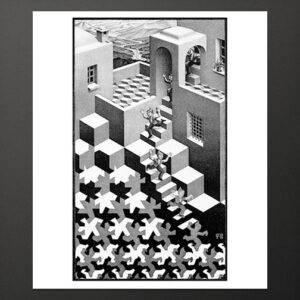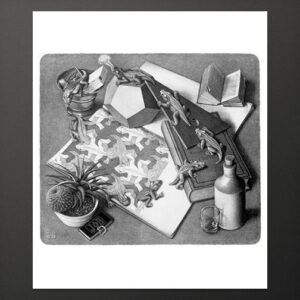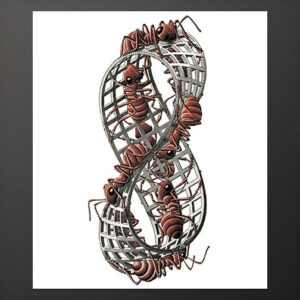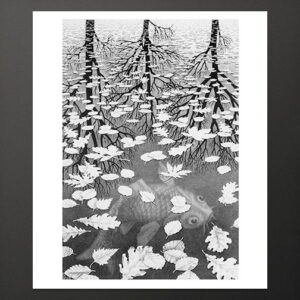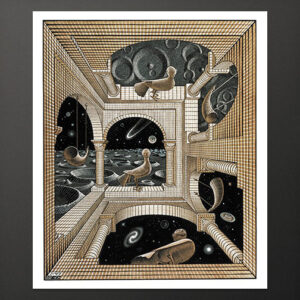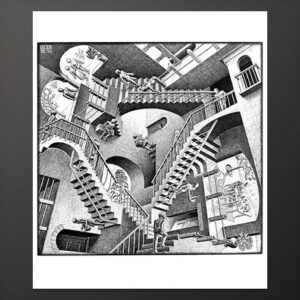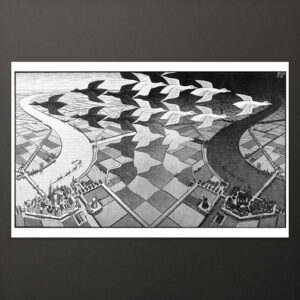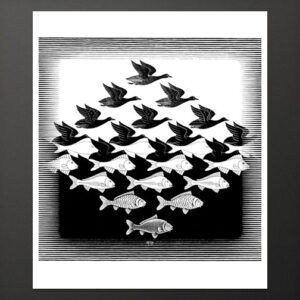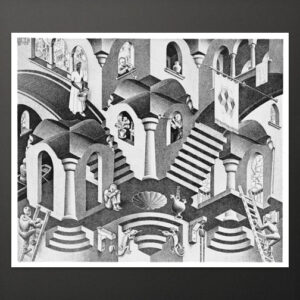-
Cycle, lithograph, 1938. "At the top right, a cheerful boy emerges from his house. As he runs down the stairs, he loses his spatiality and ends up in a pattern of flat, gray, white and black peers. Counterclockwise upwards, these simplify into diamonds. The effect of depth is regained in the combination of three diamonds that are reminiscent of a cube. The cube connects to the house from which the boy emerges again. The floor of a terrace is covered with the same well-known pattern of diamond-shaped tiles. The view above is intended as a maximum of three-dimensional naturalness, while the periodic pattern from below shows a maximum of two-dimensional consistency." ~ M.C. Escher, Grafiek en Tekeningen. Printed in black and white on poster paper. Paper size : 55 x 65 cm. Image size approx : 32 x 54,5 cm. Packaged in cardboard tube.
-
M.C. Escher’s Reptiles (1943) is a whimsical yet thought-provoking lithograph that blurs the line between two-dimensional and three-dimensional space. In this print, a series of small, tessellated reptilian figures emerge from the flat surface of a drawing, come to life, and crawl across a cluttered tabletop, only to return to their original, flat form. This cyclical movement creates a fascinating interplay between art and reality, showcasing Escher’s signature themes of transformation, illusion, and the paradoxical relationship between the flat and the spatial. With its meticulous detail and playful narrative, Reptiles invites viewers to question perception and the nature of artistic creation itself. Printed in black and white on poster paper. Packaged in cardboard tube. Paper size : 55 x 65 cm. Image size approx : 43,5 x 38 cm.
-
Möbius II, woodcut from 3 blocks, 1963. "A closed, looped ribbon usually has two separate surfaces, one inside and one outside. On this strip, however, nine red ants follow each other and walk both the front and the reverse side. So the ribbon has only one surface." ~ M.C. Escher, Grafiek en Tekeningen. Printed in color on poster paper. Paper size: 55 x 65 cm. Image size approx : 27 x 58 cm. Packaged in cardboard tube.
-
Three worlds, lithograph, 1955. "The representation of this forest pond consists of three elements: the autumn leaves that indicate the plane of the water surface, the mirror images of three trees in the background, and the fish in the foreground in the transparent water." ~ M.C. Escher, Grafiek en Tekeningen. Printed in black and white on poster paper. Paper size : 55 x 65 cm. Image size approx : 40 x 58 cm. Packaged in cardboard tube.
-
Other World, wood engraving of three blocks, 1947. "The interior of a cube-shaped extension. Openings in the five visible walls offer a view of three different scenes. Through the upper pair one can see the ground, almost vertically downwards; the middle two are at eye level and show the horizon; through the lower pair, one looks steeply up at the stars. Each surface of this structure, which logically unites nadir, horizon and zenith, has a triple function. The rear surface in the center, for example, is a wall in relation to the horizon, a floor in relation to it the upper view and a ceiling with regard to the view of the starry sky." ~ M.C. Escher, Grafiek en Tekeningen. Printed in color on poster paper. Paper size: 55 x 65 cm. Image size approx : 41,5 x 50,5 cm. Packaged in cardboard tube.
-
Relativity, lithograph, 1953. "Three gravitational forces act perpendicular to each other here. Three Earth surfaces intersect each other at right angles and on each of them people live. Two inhabitants of different worlds cannot walk, sit or stand on the same floor, because their notions of what is horizontal and what is vertical are not the same. But they can use the same staircase together. On the top staircase shown here, two people move next to each other in the same direction. Yet one descends and the other climbs up. Contact between them is impossible, because they live in different worlds and therefore cannot know of each other's existence." ~ M.C. Escher, Grafiek en Tekeningen. Printed in black and white on poster paper. Paper size : 55 x 65 cm. Image size approx : 43 x 40,5 cm. Packaged in cardboard tube.
-
Day and Night, woodcut of 2 blocks, 1938. "Gray rectangular fields develop upwards into silhouettes of white and black birds; the black ones fly to the left, the white ones to the right as two oppositely directed formations. On the left, the white ones flow into each other and unite into a daytime sky and landscape. On the right, the black ones merge into night. The day and night landscapes are each other's mirror images, which unite by means of gray fields, from which the birds develop again." ~ M.C. Escher, Grafiek en Tekeningen. Printed in black and white on poster paper. Paper size: 86,7 x 55 cm. Image size approx 78,5 x 45,5 cm. Packaged in cardboard tube.
-
Sky and Water I, woodcut, 1938. "In the horizontal center strip, birds and fish are equal. But we associate flying with the air, so for the black bird the four white fish surrounding it are the air in which it flies. In the same way, swimming reminds us of water, so the four black birds surrounding the fish become for him the water in which he swims." ~ M.C. Escher, Grafiek en Tekeningen. Printed in black and white on poster paper. Paper size : 55 x 65 cm. Image size : 50 x 50 cm. Packaged in cardboard tube.
-
Convex and Concave, lithograph, 1955. "Next to each other are three houses with a cross vault as a roof. The left one is seen externally, the right one internally and the middle one optionally from inside or outside. There are several such inversions on this picture shown; one of them is described here. There are two boys playing the flute. One on the left looks down on the roof of the middle house; if he climbs through his window he can jump onto the roof below. If he then jumps down again, he ends up one floor lower on the dark floor in front of the house. However, the right flute player sees that same cross vault above his head as a roof before him there is no floor, but a fathomless abyss." ~ M.C. Escher, Graphics and Drawings. Printed in black and white on 170 grams poster paper. Paper size : 55 x 65 cm. Image size : 56 x 47 cm. Packaged in cardboard tube.

